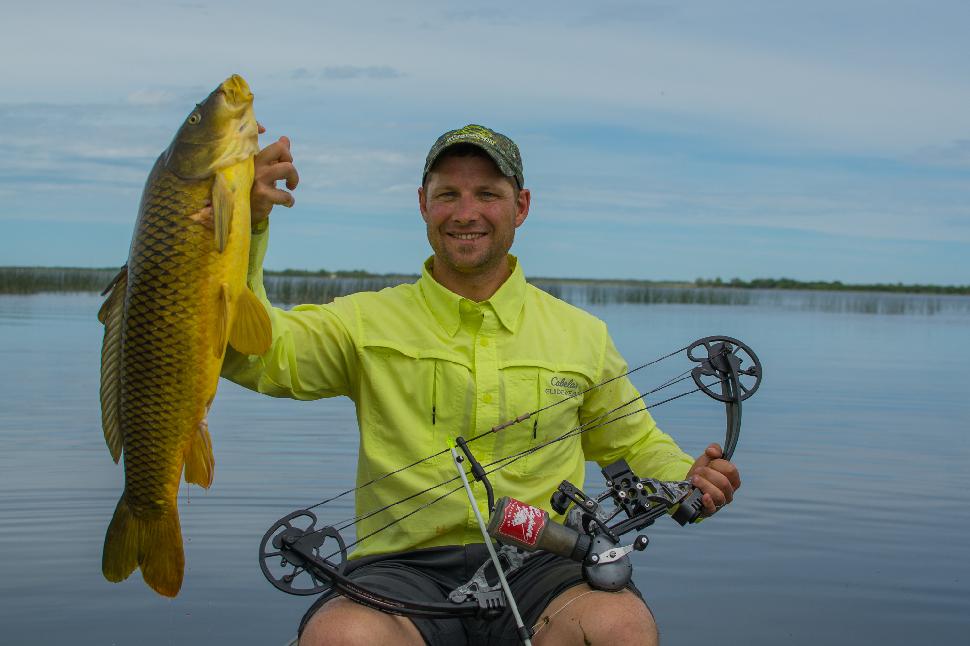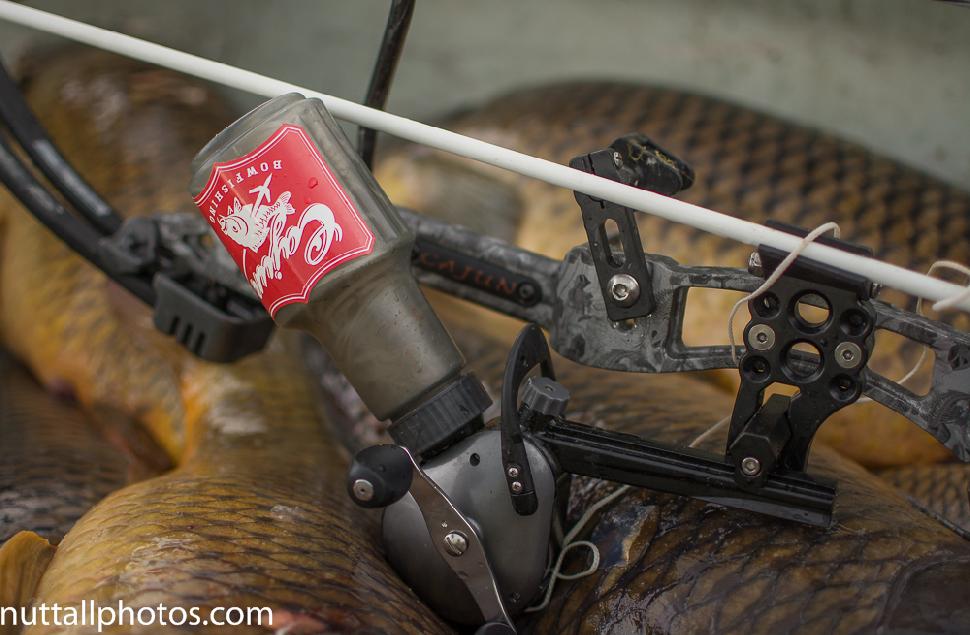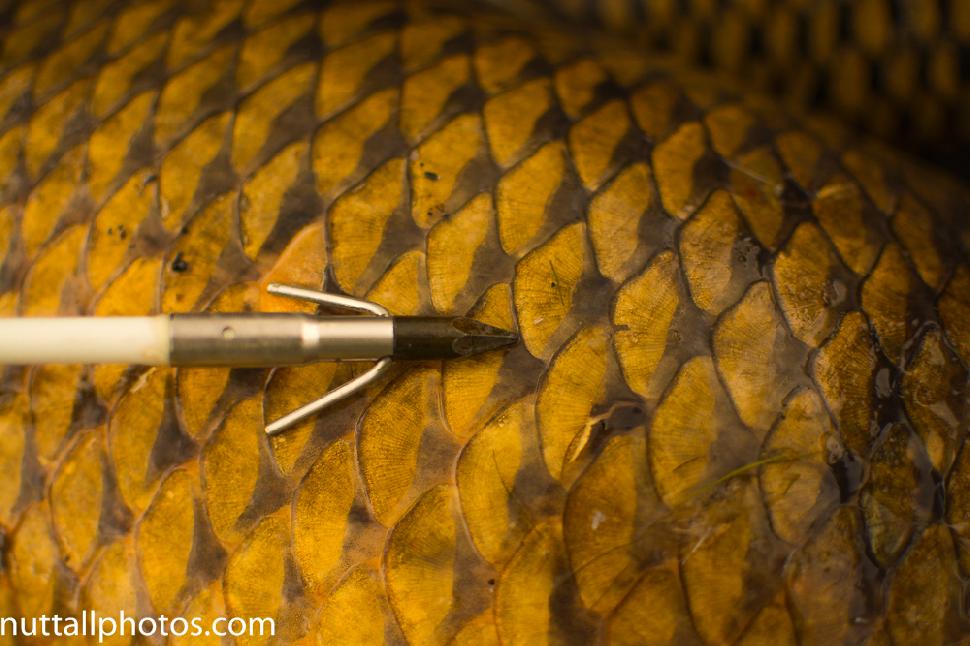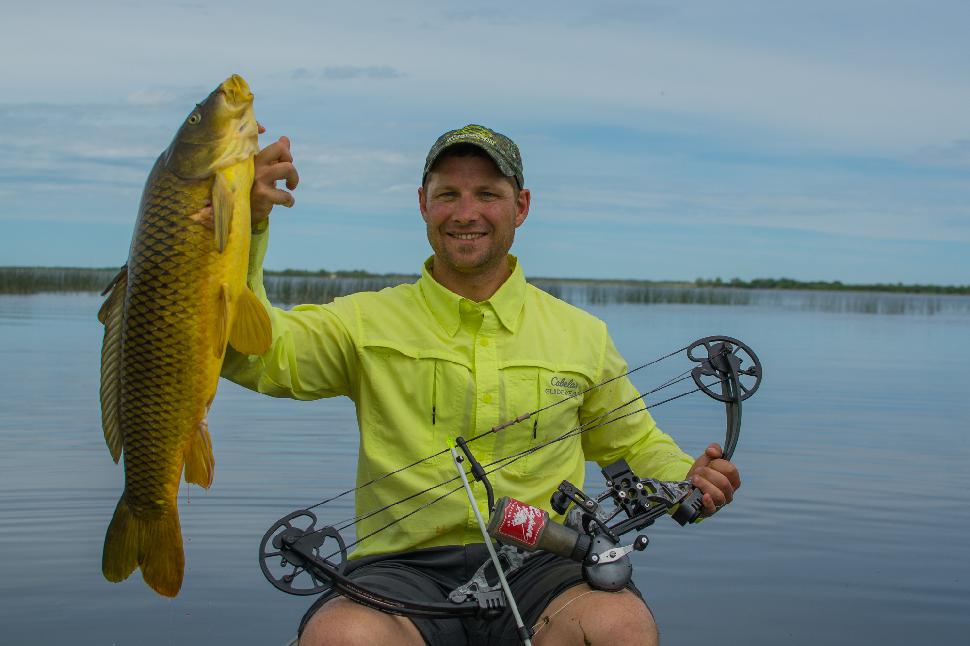Short and Sandals Bowhunting
Bowfishing combines fishing and hunting for summer time fun
Advertisement

In mid June, I brought Cabela`s archery department manager (Dustin) bowfishing to Saskatchewan to arrow giant invasive carp. In previous years, I bowfished in early June during the spawn but considering what carp consume in their habitat, I figured they would still be shallow enough to see and shoot. The weather forecast was hot and sunny, perfect for bowhunting in shorts and sandals.

Cajun Sucker Punch bowfishing bow comes with a bottle-fed reel which has easy and hassle and tangle free quick operation for releasing many arrows without fail.
Advertisement

Barb are required to ensnare the targeted fish. These deadly points make bowfshing a non-catch and release sport.
Gear
Essential bowfishing gear consists of six items: bow, reel, line, arrow, arrow-tip and arrow-rest. My bow was a Cajun sucker punch tuned at Cabela`s by Dustin before we left and set to forty five pound draw without any let-off. I prefer quick snap shooting bows when bowfishing for carp as the shooting opportunities materialize quickly as the fish swim into view. My sucker punch was equipped with a bottle fed reel to store the line. Bottle style reels quickly crank in line and are hassle free when nocking another arrow for a shot. Reels need to be outfitted with twenty-five meters of eighty lbs (or more) test of super braided brightly colored line. Fiberglass arrows weighing 1200 to 1500 grains provide excellent penetrating punch to ensnare targeted fish. Bowfishing arrow tips need barbs so the arrow hold in the fish and allows the angler to reel the fish in. Securing the line to your arrows safety slide keeps the line in front of the riser reducing entanglements and preventing dangerous ‘snap-back’, reducing chances of injury. The paying-out line stabilizes the solid fiberglass bare shaft arrows making fletchings unnecessary as they could also misdirect a submerging arrow. Arrow rests must be simple, durable and strong enough to hold these heavy arrows. Unfortunately, wisker biskets do not work well for good arrow flight as the fletch-less arrows have a stop point screwed into them near the rear to the safety slide from coming off. Always carry spare parts and spare arrows. On person gear consists of polarized sunglasses, which are a must to see swimming fish.

Advertisement
Wedging the canoe into a weed-bed, allowed Dustin to blend nicely and disguises the canoe somewhat providing excellent ambushing opportunities for carp swimming nearby. It wasn`t long before he hauled another carp into the boat.
Technique
I have shot fish from: high above small boat platforms, in knee deep water with waders, the shores edges hidden in tall weeds and most recently from a stable canoe. Every method has pros and cons and works. The big advantage from shooting off an elevated platform like a boat is stealthy mobility and a bird’s eye perspective of swimming fish. However, it seems carp fear coming close to boats so the shots are longer than with your feet planted on the ground. The best opportunities come from nestling the boat along some cover and waiting patiently for fish to swim by. In this scenario, have the sun to your back and simply wait for the fish to swim into range. It’s essential to keep sudden movement to a minimum and wait for the fish to turn broadside before drawing, otherwise you will spook them. Stalking from the ground prevents a high skylined object for fish to spot, but because your eyes are closer to the water, it’s also harder to see fish, but they tend to swim in closer to you, sometimes right through your feet. The best situation in either case is to find a swim channel through thick weeds and blend yourself into the tall weeds near by and wait – which won’t be long. I prefer the canoe because of it’s mobility, minimum draw and setup for two people to bowfish at once – one from the bow and the other off the stern. Wedging a canoe into small weed islands in the marsh keeps the boat in place and provide some cover.

Refraction makes aiming at these small targets even more challenging. After the first half a dozen shots that miss high, you start to get the hang of aiming low.
Aim low
As the sunlight travels from one medium (air) to another (water), it refects (bends), giving a false image the apparent fish compared to its actual location. The apparent fish will always appear higher than the actual fish target. For this reason, it’s important to aim low, but how low? That depends on the depth of the fish and how far away from you it is. During this last trip, most of our fish were always two feet deep and 10 – 20 feet away. When 10 feet away, aiming nine inches low worked well. At twenty feet away, 18 inches worked well. Fish less than one foot deep don’t need that much aim point compensation, but you still have to aim low, just underneath the body on these large twenty pound carp. I have taken head on shots and they work well assuming you can draw your bow without spooking the fish. I like the head on shots because your margin of error with regards to high/low is increased from broadside shots.

This past day trip, Dustin and I both took over 40 shots each and managed to bring in a few. For the most part, the carp were two feet down and at 10 to 20 feet away – challenging bowfishing shots.
Days Catch
Bowfishing for carp is not catch-and-release and not favored table fare, canning them being the exception. However, I did up a fish fry from this past trip and we enjoyed an organic meal. Helping to manage these invasive fish by supplying pet food companies with your harvest goes a long way to boast a positive image for bowfishing. In my case, I am using them for trapline bait to help control the wolf population. Saskachewan recently changes the regulation for bowfishing making it illegal to waste your catch. Even though the fish are still classified as invasive they have been swimming in many water system for 30+ years, but shooting dozens of fish and leaving them to rot along the banks does not boast a positive image for bowfishing, nor the ideal image of Saskatchewan. With a little thought and effort, pay your catch forward to helping another cause
This video demonstrates a typical bowfishing shot from shore.
After bowfishing, fish Saskachewan`s hotspot for other species
Last Mountain Lake
SpeciesBurbot, Carp, Perch, Pike, Walleye/Pickerel, WhitefishLocation: Saskatchewan Surface area: 2,312 km² In 2012, ranked #29 in all-time hot spots Just north of Regina, at the head of…Read More >Tweet




XML Sitemap



